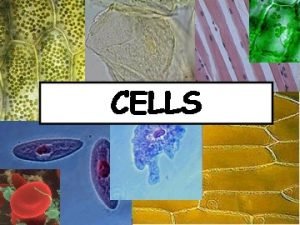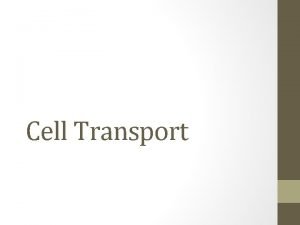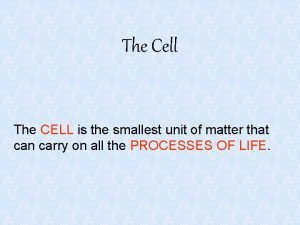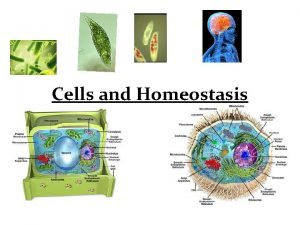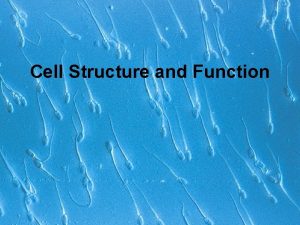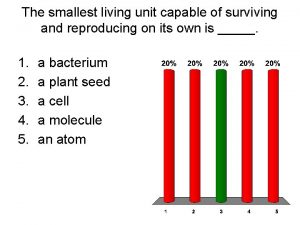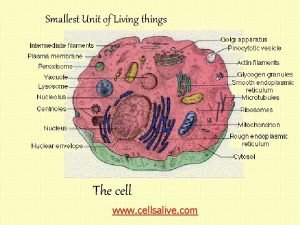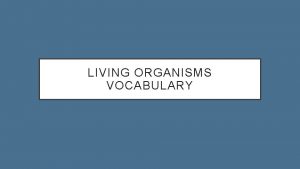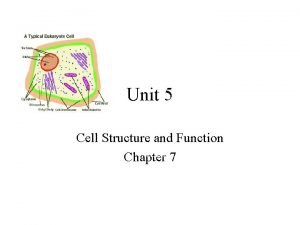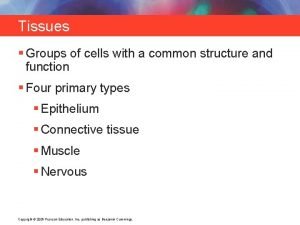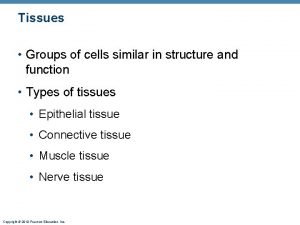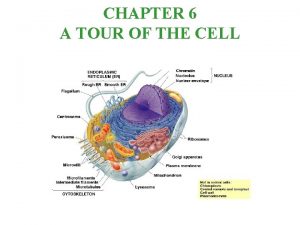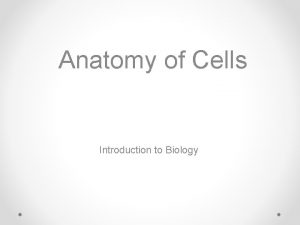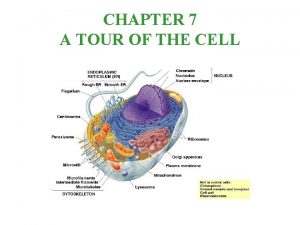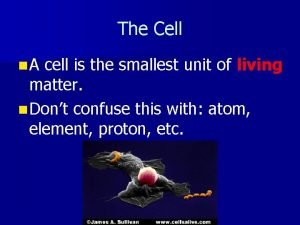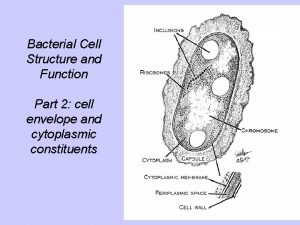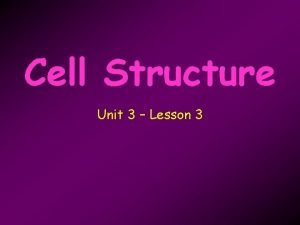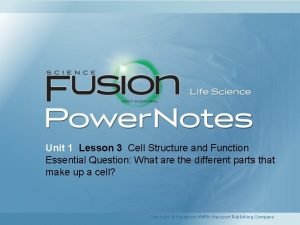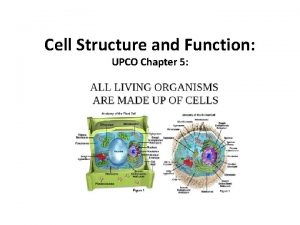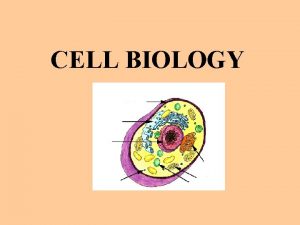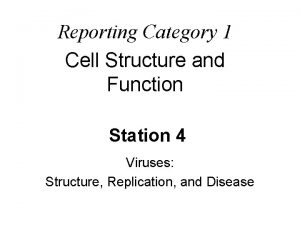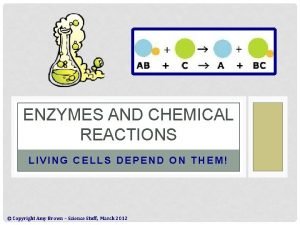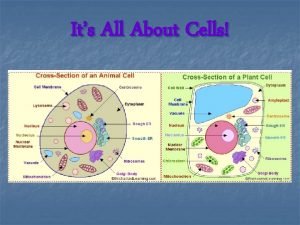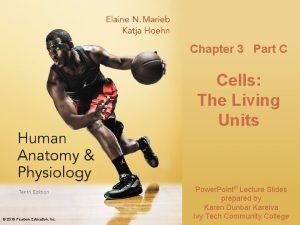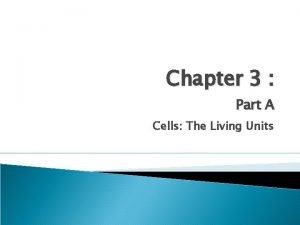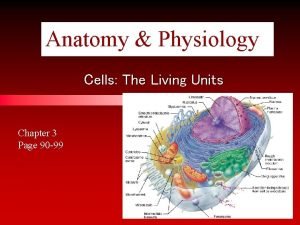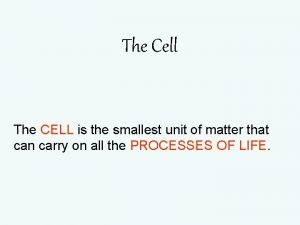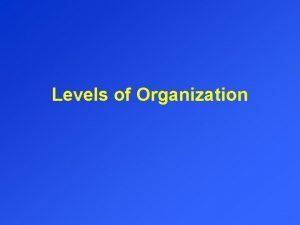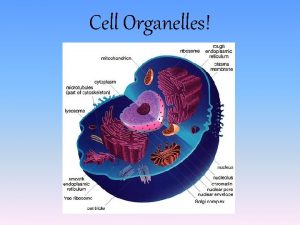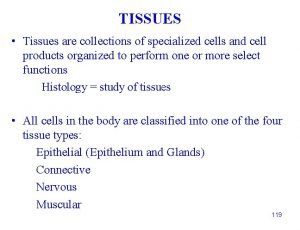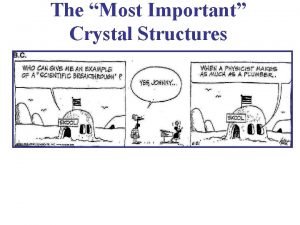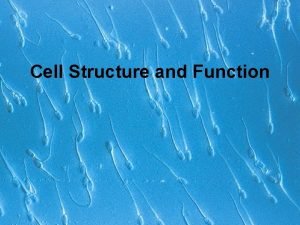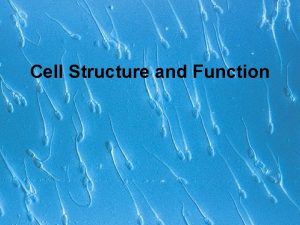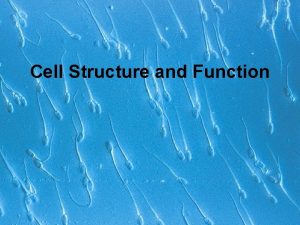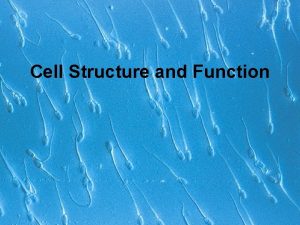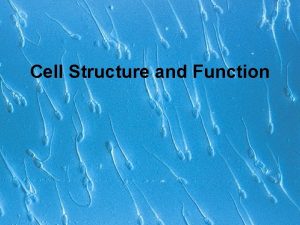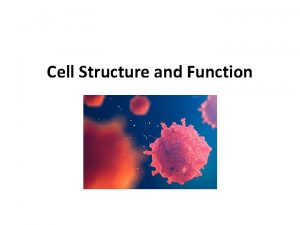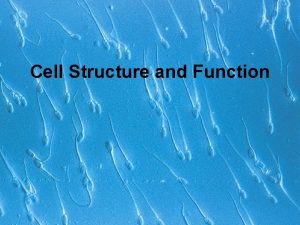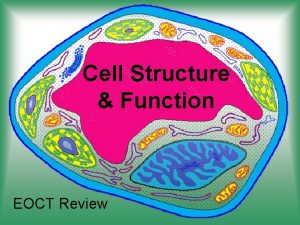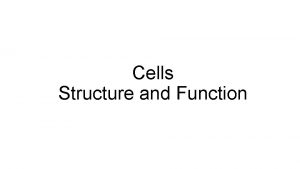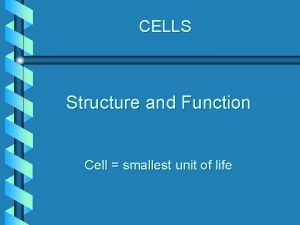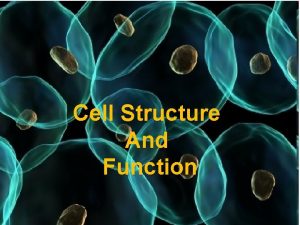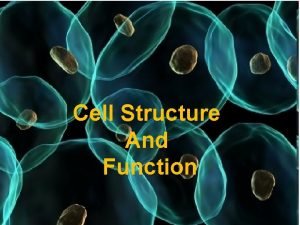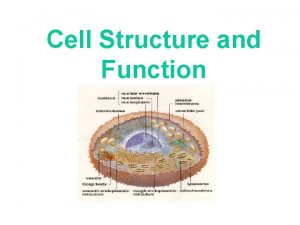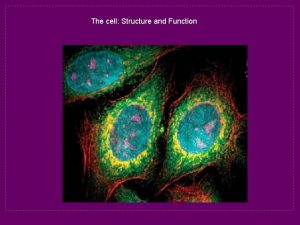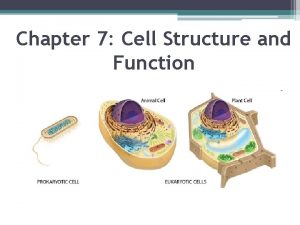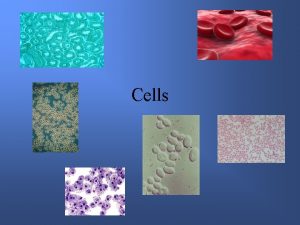Cell Structure and Function Cells Smallest living unit






























































- Slides: 62

Cell Structure and Function

Cells • Smallest living unit • Most are microscopic

Discovery of Cells • Robert Hooke (mid-1600 s) – Observed sliver of cork – Saw “row of empty boxes” – Coined the term cell

Cell theory • (1839)Theodor Schwann & Matthias Schleiden “ all living things are made of cells” • (50 yrs. later) Rudolf Virchow “all cells come from cells”

Principles of Cell Theory 1. All living things are made of cells 2. Smallest living organism is a cell 3. All cells arise from preexisting cells (no spontaneous generation)

Cell Size

Why are cells so small? What’s keeping them from being larger? • Cells must divide when volume exceeds surface area to keep Surface Area to Volume Ratio high. Why? video

• • Characteristics of All Cells An outer membrane Cytoplasm (or cytosol) –thick fluid DNA Organelles (“little organs”)

Cell Types Prokaryotic Eukaryotic

Prokaryotic Cells • • • First cell type on earth bacteria No nucleus or membrane-bound organelles DNA in nucleoid region Have cell membrane and cell wall may have a capsule and pili

Eukaryotic Cells: protistas, fungi, animals, plants PLANT CELL PROTISTAS (UNICELLULAR EUKARYOTES) FUNGI CELL ANIMAL CELL

Organelles • Cellular “organs” – Membrane-organelles (Golgi, RER, nucleus…) – Non-membrane – organelles (ribosomes) – Bacteria-like organelles (chloroplast, mitochondria)

Bacteria-Like Organelles • Derived from symbiotic bacteria • Mitochondria, chloroplasts • Endosymbiotic theory – Evolution of modern cells from cells & symbiotic bacteria

Eukaryotic Cells • Nucleus bound by membrane • Include fungi, protists, plant, and animal cells • Possess many organelles Protozoan

Representative Animal Cell

Representative Plant Cell

Plasma Membrane • Contains cell contents • Double layer of phospholipids & proteins

Phospholipids • Polar – Hydrophylic head – Hydrophobic tail • Interacts with water

Membrane Proteins 1. Channels or transporters – Move molecules in one direction 2. Receptors – Recognize certain chemicals

Membrane Proteins 3. Glycoproteins – Identify cell type 4. Enzymes – Catalyze production of substances

Cell Walls • Found in plants, fungi, & many protists • Surrounds plasma membrane

Cell Wall Differences • Plants – mostly cellulose • Fungi – contain chitin • Bacteria - peptidoglycan

Cytoplasm • Viscous fluid containing organelles • components of cytoplasm – – Interconnected filaments & fibers Fluid = cytosol Organelles (not nucleus) storage substances

Cytoskeleton • Filaments & fibers • Made of 3 fiber types – Microfilaments – Microtubules – Intermediate filaments • 3 functions: – mechanical support – anchor organelles – help move substances

A = actin, IF = intermediate filament, MT = microtubule

Cilia & Flagella • Provide motility • Cilia – Short – Used to move substances outside human cells • Flagella – Whip-like extensions – Found on sperm cells

Cilia & Flagella Structure • Bundles of microtubules • With plasma membrane

Centrioles • Pairs of microtubular structures • Play a role in cell division

Membranous Organelles • Functional components within cytoplasm • Bound by membranes

Nucleus • Control center of cell • Double membrane • Contains – Chromosomes – Nucleolus

Nuclear Envelope • Separates nucleus from rest of cell • Double membrane • Has pores

DNA • Hereditary material • Chromosomes – DNA – Protiens – Form for cell division • Chromatin

Nucleolus • Most cells have 2 or more • Directs synthesis of RNA • Forms ribosomes

Endoplasmic Reticulum • Helps move substances within cells • Network of interconnected membranes • Two types – Rough endoplasmic reticulum – Smooth endoplasmic reticulum

Rough Endoplasmic Reticulum • Ribosomes attached to surface – Manufacture protiens – Not all ribosomes attached to rough ER • May modify proteins from ribosomes

Smooth Endoplasmic Reticulum • No attached ribosomes • Has enzymes that help build molecules – Carbohydrates – Lipids

Golgi Apparatus • Involved in synthesis of plant cell wall • Packaging & shipping station of cell

Golgi Apparatus Function 1. Molecules come in vesicles 2. Vesicles fuse with Golgi membrane 3. Molecules may be modified by Golgi

Golgi Apparatus Function (Continued) 4. Molecules pinched-off in separate vesicle 5. Vesicle leaves Golgi apparatus 6. Vesicles may combine with plasma membrane to secrete contents


Lysosomes • Contain digestive enzymes • Functions – Aid in cell renewal – Break down old cell parts – Digests invaders

Vacuoles • Membrane bound storage sacs • More common in plants than animals • Contents – Water – Food – wastes

Bacteria-Like Organelles • Release & store energy • Types – Mitochondria (release energy) – Chloroplasts (store energy)

Mitochondria • Have their own DNA • Bound by double membrane

Mitochondria • Break down fuel molecules (cellular respiration) – Glucose – Fatty acids • Release energy – ATP

Chloroplasts • Derived form photosynthetic bacteria • Solar energy capturing organelle

Photosynthesis • Takes place in the chloroplast • Makes cellular food – glucose

Review of Eukaryotic Cells

Review of Eukaryotic Cells


Movement of Substances Across the Plasma Membrane • A few molecules move freely – Water, Carbon dioxide, Ammonia, Oxygen • Carrier proteins: – transport some molecules – embedded in lipid bilayer carrier proteins video • Fluid mosaic model – describes fluid nature of a lipid bilayer with proteins • fluid mosaic video


Molecule Movement & Cells • Passive Transport: – No use of energy: • Diffusion • Osmosis • Facilitated Diffusion (uses protein carriers) • Active Transport: – Uses energy (ATP) • Endocytosis (materials move into cell, ex. : phagocytosis and pinocytosis) • Exocytosis (materials move out)

Passive Transport • No energy required • Move due to gradient: – differences in concentration, pressure, charge • Move to equalize gradient – High moves toward low

Diffusion • Molecules move to equalize concentration High sugar concentration Low sugar concentration

Osmosis • Special form of diffusion • Fluid flows from lower solute concentration • Often involves movement of water through a selectively permeable membrane: – Into cell – Out of cell

Solution Differences & Cells • solvent + solute = solution • Hypotonic – Less water in cell than outside – Water will flow into cell • Isotonic – Water amounts equal inside & out of cell • Hypertonic – More water in cell than outside – water will flow out of cell


Facilitated Diffusion • Protein Channels (are specific) help molecule or ions enter or leave the cell • No energy is used 1. Protein binds with molecule 2. Shape of protein changes 3. Molecule moves across membrane transport video

Active Transport • Requires energy (against gradient) • Example is sodium-potassium pump:

Endocytosis • Movement of large material into cells: 1. Plasma membrane surrounds material 2. Edges of membrane meet 3. Membranes fuse to form vesicle “cell eating” amoeba "eating" paramecium “cell drinking”

Exocytosis • Reverse of endocytosis • Cell discharges material • exocytosis video
 Mitochondria information
Mitochondria information What is the smallest unit of life
What is the smallest unit of life Cells are the smallest unit of life
Cells are the smallest unit of life A cell is the smallest unit of life
A cell is the smallest unit of life The smallest unit of living thing
The smallest unit of living thing The smallest living unit is a
The smallest living unit is a What is the smallest living unit in the body
What is the smallest living unit in the body What is the smallest living unit
What is the smallest living unit Smallest living unit
Smallest living unit What is the smallest unit of a living organism
What is the smallest unit of a living organism What is the smallest unit of living organisms
What is the smallest unit of living organisms Unit 5 cell structure and function answer key
Unit 5 cell structure and function answer key Muscle tissue parts
Muscle tissue parts Groups of cells that are similar in structure and function
Groups of cells that are similar in structure and function A group of cells similar in structure and function
A group of cells similar in structure and function The cell is a living unit greater than the sum of its parts
The cell is a living unit greater than the sum of its parts Capsule flagella pili nucleoid desmosome
Capsule flagella pili nucleoid desmosome Microfilament function
Microfilament function Smallest cells
Smallest cells Submentovertical projection
Submentovertical projection Red blood cells and white blood cells difference
Red blood cells and white blood cells difference Plant cell and animal cell venn diagram
Plant cell and animal cell venn diagram Masses of cells form and steal nutrients from healthy cells
Masses of cells form and steal nutrients from healthy cells Cell wall function
Cell wall function Venn diagram of living and nonliving things
Venn diagram of living and nonliving things What is part 2
What is part 2 Lesson 3 cell structure and function answer key
Lesson 3 cell structure and function answer key Cell organelles structures and functions organizer
Cell organelles structures and functions organizer Difference between plant cell and bacterial cell
Difference between plant cell and bacterial cell What cell is this
What cell is this Eukaryotic cell structure
Eukaryotic cell structure Chapter 7 cell structure and function section review 7-2
Chapter 7 cell structure and function section review 7-2 Cell organelle graphic organizer
Cell organelle graphic organizer Chapter 5 cell structure and function
Chapter 5 cell structure and function Plastids in plant cell
Plastids in plant cell Category 1 cell structure and function
Category 1 cell structure and function Category 1 cell structure and function
Category 1 cell structure and function Category 1: cell structure and function
Category 1: cell structure and function Alpha intercalated cells
Alpha intercalated cells Parafollicular cells vs follicular cells
Parafollicular cells vs follicular cells How are mitosis and meiosis similar
How are mitosis and meiosis similar Somatic cells vs germ cells
Somatic cells vs germ cells Eukaryotic vs prokaryotic cells
Eukaryotic vs prokaryotic cells Prokaryotic vs eukaryotic cells venn diagram
Prokaryotic vs eukaryotic cells venn diagram Organelle trail
Organelle trail Younger cells cuboidal older cells flattened
Younger cells cuboidal older cells flattened Cuál es la diferencia entre la célula animal y vegetal
Cuál es la diferencia entre la célula animal y vegetal Which organisms are prokaryotes
Which organisms are prokaryotes Chapter 8 cellular reproduction cells from cells
Chapter 8 cellular reproduction cells from cells Cells cells they're made of organelles meme
Cells cells they're made of organelles meme Enzymes affect reactions in living cells by changing the
Enzymes affect reactions in living cells by changing the Tissue are grouped together to form various
Tissue are grouped together to form various Are chromosomes living or nonliving
Are chromosomes living or nonliving Rough er
Rough er Chapter 3 cells the living units
Chapter 3 cells the living units Mitosis
Mitosis Robert hooke
Robert hooke Which of the following is the smallest part of a plant
Which of the following is the smallest part of a plant Smallest organelle in a cell
Smallest organelle in a cell Collection of specialized cells and cell products
Collection of specialized cells and cell products Tomato living or nonliving
Tomato living or nonliving Living non living dead
Living non living dead Zns crystal structure unit cell
Zns crystal structure unit cell

